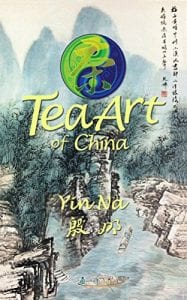 This was a book I received back at 2017’s Vancouver Tea Festival. The author had a booth at the event, and I also attended her talk on the different tea-growing regions of China.
This was a book I received back at 2017’s Vancouver Tea Festival. The author had a booth at the event, and I also attended her talk on the different tea-growing regions of China.
I never really spoke to her directly, but thought her talk was pretty interesting (I was the nerd up-front taking notes, naturally). The book was gifted by someone else running the booth as a copy to review. And then… I didn’t get around to it, as I got caught up in trying to finish my degree.
Unfortunately, the review got put on the backburner even longer–half-finished as I looked for a job and ended up losing all of my free time in the process. I had notes prepared, at one point, but I’ve since lost them.
I’ll forewarn that the book does come with its share of awkward wording and grammatical errors, as English is not Yun Na’s first language, but if you can look past that, it’s a nice enough read, if a bit forgettable. The book’s construction was lacking–glue binding started to break as soon as I cracked the spine. Unfortunate, but maybe I’ll look up some DIY book-binding tutorials.
This is definitely a book worth including the Table of Contents for, so that will be linked at the end of the post (rather, the Amazon page that includes the TOC). The book isn’t long (130 pages), broken into five chapters, following the classic standard of most ‘tea guides’: History, Choosing Tea, Making Tea, Tea Culture, Tea Information. Overall the book has a sort of spiritual lean, but does still have a lot of information on tea history and culture. There’s some on myths, but grounding them in their history, and a strong rooting in Chinese medicine. That first chapter spends time on people’s philosophy and approaches to tea, from China’s perspective. Tasting techniques, and one’s relationship with the culture. There is an interesting emphasis on the ‘myth’ that Japan’s tea culture has ‘ceremony’ and China’s doesn’t (this’ also the source of the book name: Tea as an Art, basically). It tries to debunk this, but feels like it spends too much time putting down Japan’s tea culture in the process. It does touch on the two times in history of China’s tea culture jumping to Japan, but not much.
The later chapters detailing tea types don’t go into much depth (the one on black mentions ‘three categories’: Lapsang Souchong, Keemun Gongfu, and Yunnan Gongfu), just a general overview and not much into processing. There’s an emphasis on purported health benefits.
Chapters four and five are probably what I’d reference back to the most. Four details gongfu but also several rural native customs (as well as hitting the ‘majors’ like Tibetan Butter Tea), and the wu-wo tea ceremony (translated as ‘Without Me Tea’, here). The last chapter in particular deviates a bit from what you would expect, with focus on recent issues in tea-production in China. The tea market, new-style tea gardens, and then a more general sections of places worth visiting.
One thing that irks me is all the little tidbits of tea history and references, but there’s no bibliography of works I can go snoop. I doubt they would be in English anyhow, but still.
In the end, I think it’s something work picking up from a library. Maybe not worth owning for reference, but a solid little read.




24/12/2019 at 6:27 AM
Apart from the last chapter, what are the differences with other “similar” tea guides or tea culture guides?
25/12/2019 at 12:14 PM
This one definitely doesn’t lay the information out in organized “bite sizes”. It doesn’t flow like a classic guide–in the way that most guides are sort of designed to be easily referencable.
It more flows like a story, focusing on the author’s favourite topics and areas of expertise.
It’s definitely a bit limited compared to traditional “guides”, and you sort of have to dig to find the interesting bits of unique information that aren’t just repeated from other works.